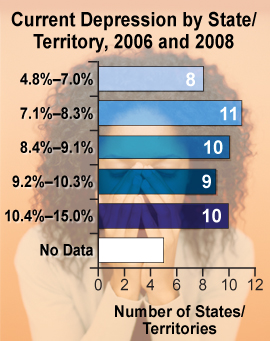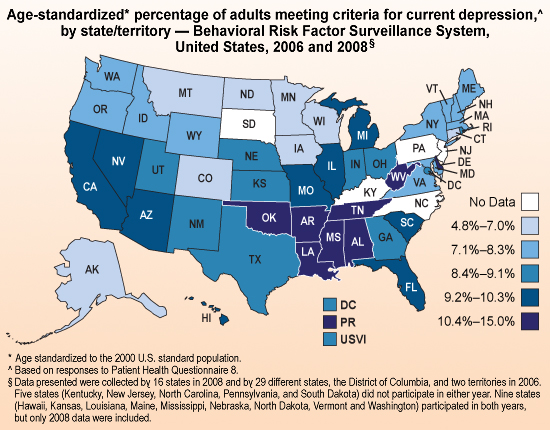An Estimated 1 in 10 U.S. Adults Report Depression
Depression affects many Americans at different levels. Learn how you can work with health providers to treat and monitor depression.
 Depression is a mental illness that can be costly and debilitating to sufferers. Depression can adversely affect the course and outcome of common chronic conditions, such as arthritis, asthma, cardiovascular disease, cancer, diabetes, and obesity. Depression also can result in increased work absenteeism, short-term disability, and decreased productivity.
Depression is a mental illness that can be costly and debilitating to sufferers. Depression can adversely affect the course and outcome of common chronic conditions, such as arthritis, asthma, cardiovascular disease, cancer, diabetes, and obesity. Depression also can result in increased work absenteeism, short-term disability, and decreased productivity.
Issuance of an Erratum
In an MMWR article entitled CDC. Current Depression Among Adults --- United States, 2006 and 2008 (MMWR 2010;59(38);1229-1235), the Behavioral Risk Factor Surveillance Survey was used to estimate the prevalence of major and "other depression" during the 2 weeks preceding the survey. Due to a statistical programming problem, this report contained multiple errors, resulting in slight changes to all estimates and confidence intervals. These errors do not represent a change in the public health message or patterns indicated by the first report. The correct estimates and confidence intervals are provided in the below text, map, and attached PDF.
Current Depression in U.S. Adults
Current depression1 was defined as meeting criteria for either major depression2 or "other depression3" (fewer symptoms than major depression, but still meet criteria for a depressive disorder according to the Diagnostic and Statistical Manual of Mental Disorders, 4th edition, could be classified as nonspecified depression or minor depression or dysthymia) during the 2 weeks preceding the survey. The MMWR report on current depression among U.S. adults summarizes the results of that analysis.
Revised estimates [PDF - 58KB] indicate that, among 235,067 adults (in 45 states, the District of Columbia [DC], Puerto Rico, and the U.S. Virgin Islands), 9.1% met the criteria for current depression (significant symptoms for at least 2 weeks before the survey), including 4.1% who met the criteria for major depression. In this study, increased prevalence of depression was found in southeastern states, where a greater prevalence of chronic conditions associated with depression has been observed (e.g., obesity and stroke). By state, age-standardized estimates for current depression ranged from 4.8% in North Dakota to 15.0% in Puerto Rico. The map below displays prevalence of current depression among US adults by state and territory for 2006 and 2008 BRFSS data.
Who Tends to be Most Depressed?
This study found the following groups to be more likely to meet criteria for major depression:
- persons 45-64 years of age
- women
- blacks, Hispanics, non-Hispanic persons of other races or multiple races
- persons with less than a high school education
- those previously married
- individuals unable to work or unemployed
- persons without health insurance coverage
Similar patterns were found among persons with "other depression" with the two following exceptions: adults aged 18-24 years were most likely to report "other depression" as were Hispanics (instead of other non-Hispanics).
Treatment of Depression
The U.S. Preventive Services Task Force recommends that health-care providers screen adults for depression when programs are in place to ensure that accurate diagnosis and effective treatment can be provided with careful monitoring and follow-up. The Task Force on Community Preventive Services recommends collaborative care, an approach that involves the collaboration of primary care providers, mental health specialists and other providers to improve disease management for adults with major depression on the basis of strong evidence of effectiveness in improving short-term depression outcomes.
1Current depression (symptoms for at least the previous two weeks) was determined based on responses to the Patient Health Questionnaire 8 (PHQ-8) (4), which covers eight of the nine criteria from the Diagnostic and Statistical Manual of Mental Disorders, Fourth Edition (DSM-IV) for diagnosis of major depressive disorder.
2Participants were considered to have major depression if, for "more than half the days," they reported meeting at least five of the eight criteria, including at least one of the following: 1) "little interest or pleasure in doing things" or 2) "feeling down, depressed, or hopeless". The other criteria are: 3) "trouble falling asleep or staying asleep or sleeping too much," 4) "feeling tired or having little energy," 5) "poor appetite or overeating," 6) feeling bad about yourself or that you were a failure or let yourself or your family down," 7) "trouble concentrating on things, such as reading the newspaper or watching television," and 8) "moving or speaking so slowly that other people could have noticed…or the opposite: being so fidgety or restless that you were moving around a lot more than usual."
3Participants were considered to have "other depression" if they met two, three, or four of the eight criteria for major depression listed above, including at least 1 of the following 1) "little interest or pleasure in doing things" or 2) "feeling down, depressed, or hopeless."

Data Source: CDC. Current Depression Among Adults --- United States, 2006 and 2008. MMWR 2010;59(38);1229-1235. (this map includes revised state estimates)
More Information
Get email updates
To receive email updates about this page, enter your email address:
Contact Us:
- Centers for Disease Control and Prevention
1600 Clifton Rd
Atlanta, GA 30333 - 800-CDC-INFO
(800-232-4636)
TTY: (888) 232-6348 - Contact CDC-INFO



